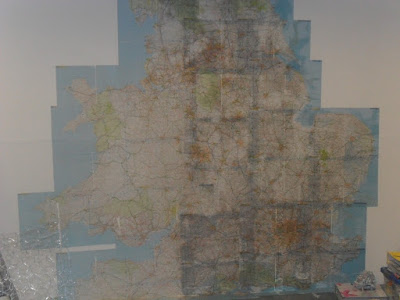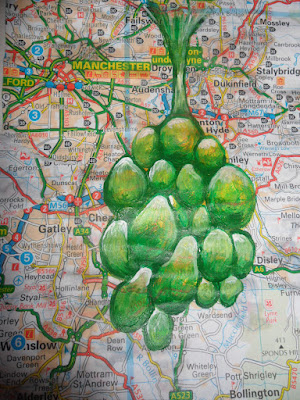 Anigail Reynolds
Anigail ReynoldsMOUNT FEAR Statistics for Violent offences 2001-02 Central Manchester (2003)
130 layers of 10mm polystyrene with sprayed finish. Laminate plinth.
Scale: 1:22,000 (1cm:22m) Relief: 1:24 (1 layer represents 24 offences per km2)
Height 203cm (including plinth)

MOUNT FEAR Statistics for Crimes with Offensive Weapon South London 2001-2002 (2002) corrugated cardboard 2.3m x 1.85m x height 1.85m
Relief 1:3,000 (1m = 3km) and 1: 13.6364 (1 event per km2 per 13.6364) Greatest peak is at 44.8 incidents per km2 per annum

MOUNT FEAR Statistics for Sex Crimes Eindhoven 1998 and 2003 (2004)
Scale: 1:3,300 (1cm:33m) Relief: 1:2 (1 cm represents 2 offences per km2)
A five year comparison of data. The two models (each 2m x 2.5m) are identical in area, crime type and scale. 500 layers of roofing felt weighing 4.5 tonnes.

MOUNT FEAR East London. Police Statistics for violent crimes 2002-3 (2003)
Dimensions 5m40 x 4m25 height 1m45
New Contemporaries 2003, London. Cardboard.

Abigail Raynolds focused her art on some of the crime statistics of Britain. The terrain of Mount Fear is generated by data sets relating to the frequency and position of urban crimes. Precise statistics are provided by the police. Each individual incident adds to the height of the model, forming a mountainous terrain.
All Mount Fear models are built on the same principals. The imaginative fantasy space seemingly proposed by the scupture is subverted by the hard facts and logic of the criteria that shape it. The object does not describe an ideal other-worldly space separated from lived reality, but conversely describes in relentless detail the actuality of life on the city streets.
Her work is factual, using alternative ways to display graphic information.
CRIME AND OFFICIAL STATISTICSMany theories of crime are based on official statistics provided by the police, courts and other government agencies involved in law enforcements. In countries such as Britain and the USA. These statistics consistently show that some groups are more involved in crime than others. The working class, the young, males, and members of some ethnic minorities are all more likely to commit crime than middle class, the elderly, females and white - according to official data. Some sociologists have taken these figures at face value and have then proceeded to explain why such groups should be criminal. Merton, Cohen and Cloward & Ohlin all assume working-class men are main offenders, although they differ in their explanation as to why this should be so. If it could be shown that the reliability of the figures is open to question, it would raise serious doubts about their theories. In Britain, official statistics on crime are published annually. They provide criminologists, the police, the courts, the media, and anyone else who is interested, with two main types of data:
1.) British crime trends and trends in recorded crime in England & Wales. British crime trends - prove information on the total number of crimes 'known to the police' This information is often taken as an accurate measure of the total amount of crime the data allows comparisons to be made between crimes, and with previous years often the figures receive widespread publicity through the media, particular if they show increases in crime over previous years.
2.) The official statistics provide information on the social Characteristics of those who have been convicted of offences, such as their age and gender.. it is on figures that a number of theories of crime have been based.
Unrecorded crime - not all crimes are recorded by police. There is much evidence of the substantial 'dark figure' of unrecorded crime before a crime is recorded three things must happen:
1 It must come to someones attention that a crime has taken place
2 It must be reported to the relevant agency
3 That agency must be willing to accept that the law has been broken.
Not all crimes are specific victim who is aware that they have done wrong. crimes such as tax evasion, however, do not have single victim to report the offence. In this case the victim is the community as whole, which has been deprived of tax revenue. the extent of this type of crime is difficult to measure, since it can only be uncovered by investigation. however possible to estimate the amount of crime of which victims are aware, but which is not reported to the police or not recorded as crime by them.
Victimisation studies - Involves asking individuals if them have been victims of crime in the previous year and asked whether the police they reported the crimes and whether police recorded them
Why do people fail to report crime?They thought the offence was too trivial/or police wouldn't be able to do anything
- It being a private matter or they had dealt with themselves.
- Fear of resprisals
- Fear of dislike of the police
- Or previous bad experience of police or courts.
Not all crimes reported by the police, the police did not always accept than an offence has taken place, don't always fit into crime categories used by British crime surveys while some were recorded as a different type of crime, which is unknown as 'no crime' - this is usually because police see the crime as trivial or thought the innocent dint actually occur, insufficient evidence,victim didn't want to be taken any further
White collar crimeSo far it has been suggested that official statistics do no give an accurate picture of the extent of delinquency among middle and middle/working class adolescents. there is evidence that offences commit ed by adults of high social status are less likely to lead to arrests and convictions than those coed adults of low class or status 'Sutherland - (1960)' defines white collar crime as crimes committed by persons of high social status and respectability in the course of their occupations , such crimes include bribery and corruption in business and politics, misconduct by professionals, such as doctors & lawyers, breaking trade regulations in industry, the drug laws, & safety regulations, the misuse of patients & trademarks & misrepresentation in advertising.
Some contemporary sociologists have developed a cultural explanation for crime which uses the concept of underclass rather than that of subcultures Murray (1989): do not accept that the underclass share the same values as other members of society. They see the underclass as responsible for a high proportion of crime and explain their ciminality in terms of their rejection of mainstream values and norms. Murray largely attributes the development of such, values to generosity of welfare states.

















































